Cristofano Gherardi was born in Borgo Sansepolcro. According to the account of his career by Giorgio Vasari, he trained there under Raffaellino del Colle from the age of 16. He broke off his training to enlist as a soldier in order to defend Florence from the combined papal and imperial attack of 1529-30. After the fall of Florence in 1530, he changed sides and enlisted under Alessandro Vitelli.
He remained in Florence for a period, leaving his military duties to work under Giorgio Vasari, who “conceived an extraordinary affection for him”. Thus, when Alessandro Vitelli subsequently sent Vasari (together with Antonio da Sangallo il Giovane and Pier Francesco da Viterbo) to repair the walls of Palazzo Vitelli alla Cannoniera (below) in Città di Castello, “which were threatening to fall down”, Cristofano Gherardi was among the assistants that Vasari took with him. These assistants completed, to Vasari’s designs:
-
✴friezes in “certain apartments”;
-
✴“scenes and compartments” in a bathroom; and
-
✴frescoes for the “walls of the loggia”.
Cristofano Gherardi was accused of treason after the assassination of Duke Alessandro de’ Medici in 1537. According to Vasari, Alessandro Vitelli did not help him to avoid exile from Florence at this point, “to the end that Cristofano might be ... forced to serve him in the work of his garden in Città di Castello”. Cristofano Gherardi seems to have played a leading role in the fresco decoration of the palace for about a year, before he was replaced there by Cola dell’ Amatrice.
Cristofano Gherardi worked on the decoration of Castello Bufalini at San Giustino (between Città di Castello and Borgo Sansepolcro) on a number of occasions during the period 1538-54. His work here was often interrupted by calls from Vasari. Nevertheless, the frescoes in the rooms of this residence are the best surviving testimony of his independent work.
Cristofano Gherardi was able to return to Florence in 1554, when Duke Cosimo I de’ Medici pardoned him. He began work under Vasari in Palazzo Vecchio, but this work was interrupted by his sudden death.
Città di Castello
Work at Palazzo Vitelli alla Cannoniera
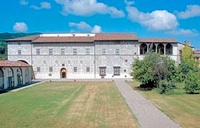
The chronology of Cristofano Gherardi’s work for Alessandro Vitelli on Palazzo Vitelli alla Cannoniera is outlined above.
Frescoes of the Garden Facade (1534-7)
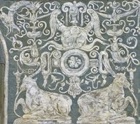
The frescoes on the arch over the street to the left must have been executed after 1543, presumably by another artist. These were largely repainted in 1912.
Frescoes of Room VIII
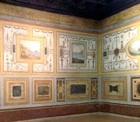
Frescoes of Room XI (later extended to form the Grande Salone)

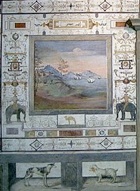
Other Frescoes in Palazzo Vitelli alla Cannoniera



Room II Room V Room VI
Other frescoes in the palace that are attributed to Cristofano Gherardi include:
-
✴the friezes of Rooms II, V and VI; and
-
✴the frescoes in the vaults of the second landing of the main staircase, which include:
-
•figures in the four main areas of the vaults of (respectively) a dragon, a sphinx with a lion’s head, a griffin and a cat, each in an oval field surrounded by grotesques; and
-
•heads in tondi of (respectively) the Emperor Augustus and the Emperor Claudius in two lunettes to the sides.
Frescoes of Palazzo Vitelli a Porta Sant' Egidio (ca. 1545-56)
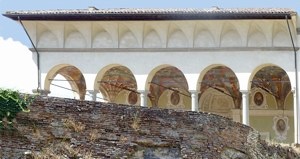
The frescoes in the loggia of the Palazzina in the garden of Palazzo Vitelli a Porta Sant' Egidio are attributed to Cristofano Gherardi. He was documented as in the service of Paolo Vitelli in a letter to Giorgio Vasari that was written in Rome in 1545.
Perugia
Frescoes (1541)
According to Giorgio Vasari, Cristofano Gherardi executed these temporary frescoes on “the portal named for Frate Ranieri” for the ceremonial entrance of Pope Paul III into the defeated city in September 1541. The new Papal Governor, Bishop Bernardino Castellario of Casale (who was known as Monsignor della Barba) commissioned the work, which included:
-
✴two figures of Jove, one of which was angry and the other pacified, on one side; and
-
✴a figure of Atlas supporting the weight of the world on the other.
The allusion to Jove was undoubtedly a reference to the conquering Paul III: similar scenes were depicted in panels attributed to Tommaso [Bernabei, il] Papacello that came from Palazzo Priori.
Frescoes in Rocca Paolina (1543-4)
Giorgio Vasari reports that Lattanzio Pagani began the decoration of the newly built Rocca Paolina. Cristofano Gherardi “not only assisted ... Lattanzio, but afterwards executed with his own hand the greater part of the best works that are painted in the apartments of that fortress, in which there also worked Raffaellino del Colle and Adone Doni of Assisi, an able and well-practised painter .... Tommaso [Bernabei, il] Papacello also worked there ...”
This is the only surviving record of the commissioning of the frescoes of Rocca Paolina. Paul III had built the fortress after his subjugation of the rebellious Perugians in 1540, so it is unsurprising that the team included no Perugian artists: indeed, apart from Dono Doni, all the artists came from outside Umbria. They were to spearhead the introduction of Mannerist art to the city of Perugino. Unfortunately, all of their work here was lost when the fortress was demolished in 1860.
Vasari is explicit the work had been commissioned by “Messer Tiberio Crispo, who was governor and castellan at that time”. A number of considerations suggest that the time in question was 1543-4:
-
✴Serafino Siepi, who described the surviving and frescoes in his guide of 1822, says that those in the chapel (which he attributed to Dono Doni) were dated by inscription to 1543;
-
✴Giorgo Vasari says that he called Cristofano Gherardi from Perugia to Rome in 1543, where he stayed for “many months”;
-
✴Raffaellino del Colle is documented in Perugia in June 1544;
-
✴Tiberio Crispo became a cardinal in December 1544, after which the title “Messer” would have been inappropriate; and
-
✴Giorgio Vasari called Cristofano Gherardi and Raffaellino del Colle (whom he describes as his “friends and pupils”) to Naples in 1545, albeit that Cristofano was too ill to respond.
If this is correct, Vasari’s reference to Tiberio Crispo as “governor and castellan” was either incorrect or perhaps was a reference to Tiberio Crispo’s position at Castel Sant’ Angelo, Rome in 1542-5. He energetically promoted the decoration of the Roman fortress during his tenure, and might also have had responsibilities at Rocca Paolina before his appointment as Cardinal Legate of Perugia (1545-8).
Santa Maria del Popolo Altarpiece (1548-9)
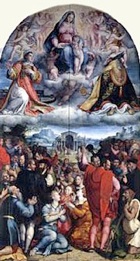
Giorgio Vasari, who provided the above information, adds that Cristofano Gherardi “painted with his own hands all the upper part, which is indeed most beautiful and worthy of great praise”. There is no documentary evidence of this assertion, but it is supported on stylistic grounds. (The two artists had already worked together at Rocca Paolina - see above).
-
✴In the upper part of the altarpiece, the Madonna is surrounded by angels and seated on a cloud. She holds the standing baby Jesus and is flanked by SS Herculanus and Laurence.
-
✴Below, the citizens of Perugia are assembled in front of a church in a landscape. While this church was probably meant to represent Santa Maria del Popolo, it is actually a direct quotation from a fresco (ca. 1525) of a scene from the life of St Catherine of Siena in Silvestro al Quirinale, Rome, which is by Polidoro da Caravaggio and Maturino da Firenze.



